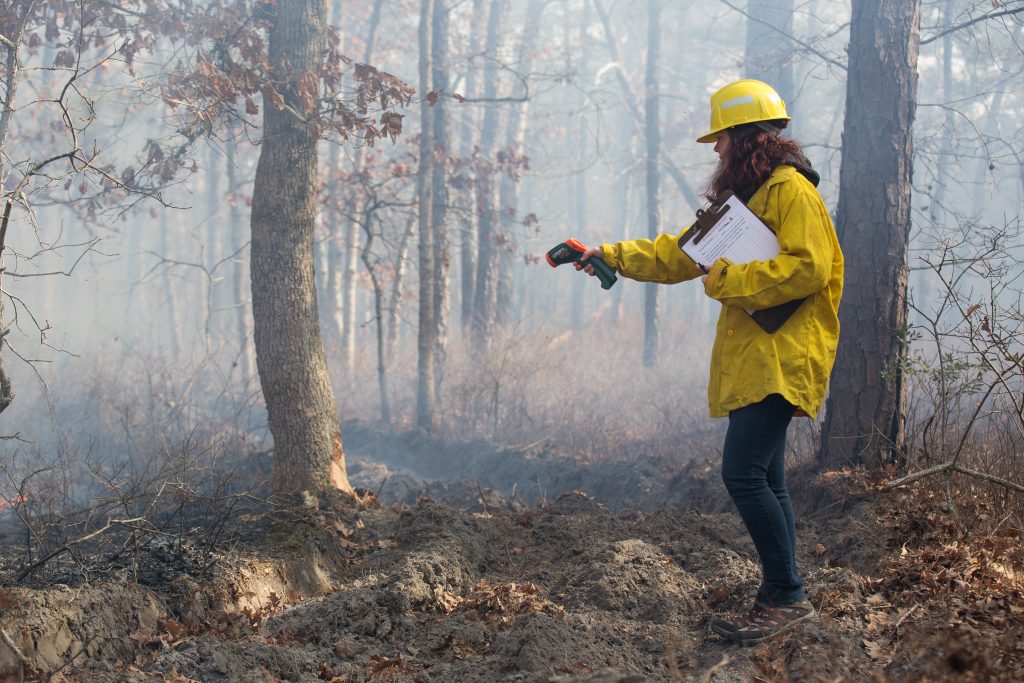
I. Trial by Fire
I wasn’t sure what to expect when I landed in California last October to attend a training event for women wildland firefighters. I was attending the second annual Women-in-Fire Prescribed Fire Training Exchange—or WTREX (pronounced ‘w-treks’)—in Yosemite National Park. It was the first time I would see so many women firefighters in the same place.
Prescribed fire training exchanges (TREXs) are 10-day-long hands-on events that have been organized across the country since 2008. They provide firefighters from different backgrounds, agencies, and skill levels the chance to learn from one another and to apply “good fire” (otherwise known as prescribed fire) to the places that need it the most. This includes any ecosystem where fire played a beneficial role historically. At TREXs, the people who fight bad fires become the ones who get to light good ones.
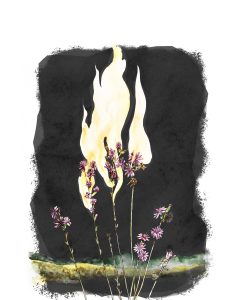
Although TREX participants generally have a wide range of qualifications—from beginner firefighters like myself to seasoned professionals—most are men. Women make up less than 10% of the wildland fire workforce. To put this in perspective, nearly twice the percentage of women serve in the military. WTREX accepted 90% women and 10% men to flip the gender ratio in the firefighting community on its head.
The idea to hold a women’s TREX began at another TREX in 2015. A number of women in leadership positions attended that event and shared their experiences of being in a male-dominated field with one another. Finding other women firefighters to connect with is a rare opportunity. To be a woman in wildland firefighting is to accept a level of solitude.
“It was really powerful,” said Nikole Simmons, one of the women who attended both the TREX in 2015 and WTREX in 2017. “We saw that there was a lack of female leaders in our experience. We said, ‘Wouldn’t it be great if we could all learn from each other?’” What began with a group of women swapping stories turned into a movement, and the first WTREX was held the next year.
I didn’t realize the importance of sisterhood in the firefighting community when I applied for a spot at the training. I came to WTREX as an outsider: a 23-year-old graduate student studying fire ecology at Yale University hoping to gain hands-on experience with prescribed fire. I had no firefighting qualifications, but I was determined to learn. I couldn’t think of a better place to do so than a training event designed specifically for women. By the end of WTREX, not only had I formed a network with these women, but something much more meaningful: a sisterhood.
What struck me most about that day—more than the firecracker sound of Mountain-laurel as its oils ignited, more than the smoke so thick it blotted out the sun, more than the heat of the flames as they licked up the cracked trunks of pine trees—was that I was one of the only women present.
I was 19 years old the first time I saw a forest burn. It was mid-March and freezing—the kind of day that winter has its claws dug into despite protestations from an approaching spring. Dozens of people were gathered in a remote area of New Jersey not to flee the flames but to watch. The New Jersey Forest Fire Service was conducting a prescribed burn on Stockton University’s campus. This burn was the start of both the school’s ten-year-long forest stewardship plan and my subsequent love for fire. I was studying forestry at the university, and I was one of a small handful of students allowed to monitor the burn that day. For those of us who lived in this region—fondly referred to as “the pinelands”—we knew that fire is an essential part of the ecosystem and in some areas of the state it had been suppressed for far too long.
I had never seen a forest fire before and experiencing it firsthand was transformative. It blazed a path for the rest of my time at Stockton University and eventually as a master’s student at the Yale School of Forestry. What struck me most about that day—more than the firecracker sound of Mountain-laurel as its oils ignited, more than the smoke so thick it blotted out the sun, more than the heat of the flames as they licked up the cracked trunks of pine trees—was that I was one of the only women present. I was the only female student to don the bright yellow, flame-retardant clothing and face the flames.
It was clear that firefighting gear was not made with 5’3” women in mind: The smallest jacket was three sizes too big on me, and the hard hat kept slipping down my forehead.
Regardless, I was determined to keep up with the Forest Fire Service as they weaved between trees and set the forest floor aflame using torches that dripped gasoline. Something about the work they were doing both excited and scared me, and for once in my life, I felt like I was doing what I was meant to be doing. Only later would I learn that women make up just one-tenth of the wildland fire workforce.
***
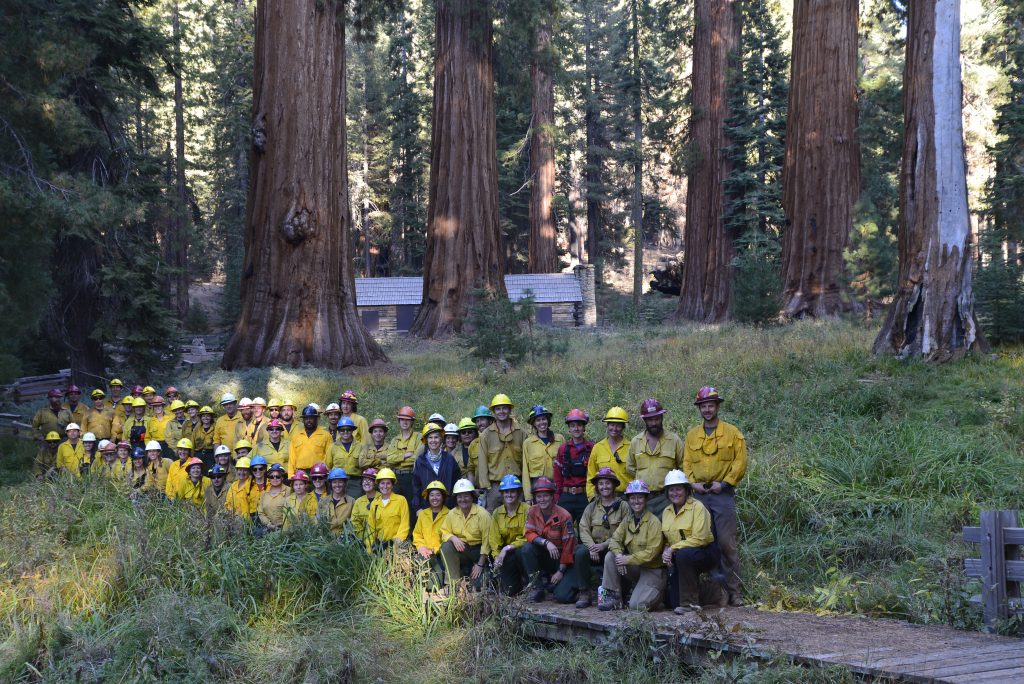
II. Go West, Young Man!
Although “wildfire” has become a buzz word among the American public, few people know the origins of wildland firefighting’s troubled past. Like other early conservation campaigns, firefighting began as a hypermasculine, militarized effort to save the nation’s natural resources from destruction. After the Great Fires of 1910, a series of wildfires that burned over three million acres in Washington, Idaho, and Montana, president Theodore Roosevelt declared wildfire one of America’s greatest enemies. Young men were trained in the ways of fighting forest fires— essentially by digging a wide line around the fire to contain it—and put out every fire that began.
“The ideal [firefighter] was someone like Frank Herring, a cowboy who had worked with Roosevelt on his ranch,” wrote Timothy Egan in The Big Burn. Firefighting was a man’s job. It required hard work and a high level of physical fitness. One of the U.S. Forest Service’s first female firefighters, Bequi Livingston, wasn’t hired until 1979. Even then, Livingston was only hired because the recruiter thought she was a man from the way she spelled her name.1
“When firefighting took hold in the West following the fires of 1910, it was men who performed the bulk of the work,” wrote Amanda Stamper, a participant of the 2016 WTREX, in a reflection after the event. “Over the past 100 years, a brotherhood has formed…In the midst of this brotherhood are amazing women, but never enough in one place and time to form a comparable sisterhood.”
Little has changed in the way forest fires are managed, or in the firefighting culture itself, despite aggressive “fire suppression” tactics being recognized as a blunder in the 1970s. Scientists noticed that ecosystems that had become “fire adapted” over thousands of years had been drastically altered by systematically extinguishing every fire. Forests have become overgrown with trees that would have been killed if natural fires were allowed to burn. Roosevelt’s legacy of fire suppression is one of the reasons for the “megafires” we see in the West today and will continue to see in the future.
Solving the wildfire problems of tomorrow begins with listening to a diversity of perspectives today and inviting participation from outside the traditionally male workforce.
Solving the wildfire problems of tomorrow begins with listening to a diversity of perspectives today and inviting participation from outside the traditionally male workforce. When it comes to fire management, WTREX is a step in the right direction. If the TREX model signifies a shift from fighting fires to lighting them, then WTREX signifies a shift in including women in the conversation.
During the two weeks I spent at WTREX in California, 17 wildfires raged across the northern part of the state. The fires killed 42 people, destroyed 9,000 structures, and burned over 245,000 acres. The 2017 fire season was the deadliest in recent history and an inopportune time for a prescribed fire training exchange—the public didn’t want more fires, even good ones. The burns we had planned for Yosemite were shut down before we had the chance to pick up our torches.
What was meant to be an opportunity for women to “put good fire on the ground” was instead a time to reflect on the current state of wildland fire management. Over the course of the two weeks, we discussed how to build a more cohesive firefighting community and brainstormed solutions to the multitude of issues women firefighters face: discrimination, harassment, and inadequate training, to name a few.
Over the past several years, there has been a push to hire more women into wildland firefighting. Many of us wondered if it was worth the effort to hire more women into a profession that’s designed to be unsupportive of them. One participant, Jeanne Pincha-Tulley, shared her ideas on the hiring process at the beginning of WTREX. Now retired, Pincha-Tulley was the country’s first female Type I Incident Commander—the firefighting community’s version of a General and the highest rank a firefighter can achieve.
“When I first came into [the Pacific Southwest Region], I was 32. We were under the Consent Decree, which meant it was being court ordered that women were put into fire,” said Pincha-Tulley. “I was the first female chief in [California], the second in the Forest Service. I was 32—think about it. How mature are 32-year-olds? Running an entire fire organization?”
“Consent Decrees” were put in place to prevent hiring discrimination in firefighting organizations, but Pincha-Tulley is hesitant about federal agencies hiring women simply to fill a quota. Part of the reason the percentage of women in leadership roles is so small (the number hovers around 7%) is because prior to being hired, they aren’t adequately trained for their role. Finding a mentor as a woman in fire is difficult. Pincha-Tulley rose to her position without the guidance of a female mentor, and her experience is similar to many others. WTREX served as a networking opportunity for younger women to connect with and learn from more experienced mentors.
Empowering women in leadership is important, but empowering women on the front lines of fire is just as necessary.
Empowering women in leadership is important, but empowering women on the front lines of fire is just as necessary. Lacey England is in her third season on the Gallatin Rappel Crew (firefighters who rappel into remote fires from a helicopter), and she’s on a mission to change the male-dominated culture from the bottom up. On the first night of WTREX, England gave a talk about using language to create a more inclusive culture. Much of the language used in the firefighting community is akin to “locker room talk,” and it can be incredibly exclusive of anyone who isn’t a white man.
“The Forest Service says they want diverse candidates, but the cultures don’t support diversity,” said England. “Language is a topic that I’m really passionate about, because I think that it’s much more powerful than we give it credit for. What we say and how we speak to each other carries a lot of weight.” England said she’s “working on” her crew and encourages them to stop using gendered terms and slurs. She says they’re slowly coming around to her progressive ideas.
“The rich culture of fire needs change, just as our lands need controlled burns to be healthier,” writes Amanda Stamper. Just as there has been a shift from suppressing fires to lighting prescribed fires, there has also been a shift in how men view women in fire.
“Most of my crewmembers believed that if a woman could hold her ground on the fireline, if she could hike and crawl and eat smoke just as well as the next guy, then she was welcome,” writes Matthew Desmond in his book On the Fireline. But significant progress takes time. Wildfires aren’t waiting for us to catch up.
***
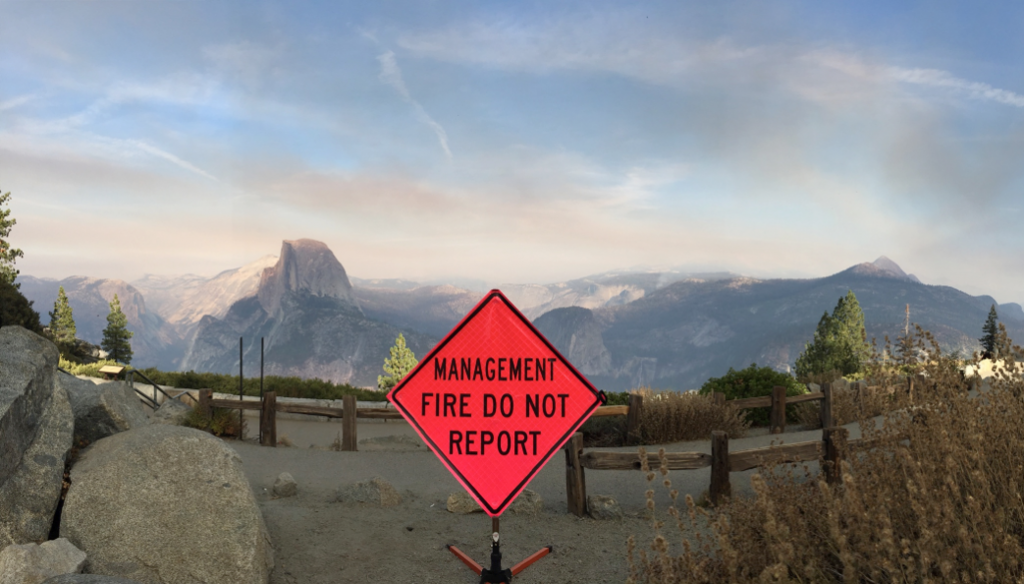
III. Lighting the Way
From atop the hill in Foresta Meadow, we can barely tell a fire burned through the area just four years ago. One of Yosemite’s iconic meadows, Foresta is a patchwork of vegetation with clusters of young trees like emerald islands among scrubby shrubs and grasses. Purple wildflowers dot the rolling hills with color. Only the charred remains of trees, scattered like spent matches throughout the meadow, ruin the illusion of serenity.
Kelly Martin, Chief of Fire and Aviation at the park, looks out at the view with pride.
Martin doesn’t look like a conventional fire chief: she has brown hair that falls past her waist and regularly wears colorful, feminine jewelry. People are often surprised when they find out she’s the chief of fire at the park—probably because she isn’t a man. She has been serving Yosemite for ten years and worked for the Forest Service for twenty years before that. She was working at the park when the Rim Fire broke out in 2013, burning more than 250,000 acres of Yosemite and the surrounding forests—the same amount of land that burned in northern California during the month of October.
The Rim Fire began as an illegal campfire, but Martin believes it did a lot of good for the park. Before the Rim Fire, some areas of Yosemite had not burned for decades. After the fire, rare species such as the black-backed woodpecker returned because of an increase in suitable habitat. Martin has a progressive approach to fire management, believing that more areas of the park need fire—prescribed or wild —and Foresta Meadow reflects that.
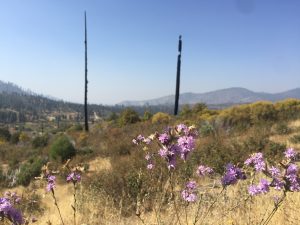
Despite the forest-health problems, Yosemite leads the way when it comes to fire management. The use of “good fire” has been identified as the leading solution to the wildfire problem, and women like Martin show how it’s done right. “I do believe that in the future we’re gonna see more smoky skies,” Martin said in an interview after the Rim Fire, referring to an increase in both prescribed and natural fires in the Sierra Nevada region.
Four years later, her words ring true. To make the most of our time at WTREX, the participants hiked into the heart of Yosemite’s wilderness and witnessed the Empire Fire—one of the park’s many “management fires”—firsthand. The Empire Fire was a naturally ignited wildfire that Martin was allowing to burn, and it was being closely monitored by other park employees. Martin told us the wildfire was nearing its “100th birthday”—it had been burning for nearly 100 consecutive days by the end of WTREX. For 100 days the fire slowly spread through the park, consuming all in its path, and creating space for new life to grow in the process.
Martin’s outlook on fire management is testament to the fresh perspectives women bring to the table. Even the public is beginning to embrace the idea of management fires in Yosemite. Towards the end of WTREX, I volunteered to stand at Glacier Point and talk to visitors about the Empire Fire. From Glacier Point, you can look down into the Illilouette Basin and see Half Dome and two of the most famous waterfalls in Yosemite. Hundreds of park goers visit this overlook every day to view the iconic dome piercing the sky, its sheer face slick and often glistening with precipitation. I stood near a neon pink road sign that read “MANAGEMENT FIRE: DO NOT REPORT”, a notice for visitors to refrain from calling park employees if they saw smoke from the lookout point.
At one point, a photographer sporting an expensive looking camera approached me. He prefaced our conversation by saying he likes to think he knows what he’s talking about because he reads the local newspapers covering the wildfire. “As a photographer, I’m disappointed,” he said, referring to the haze of smoke hanging over Half Dome, obscuring the perfect shot. “But as a conservationist, I’m happy.”
The vision of Half Dome against a clear blue backdrop is a false one, carefully crafted from the idea that national parks should be a pristine wilderness, untouched by man and Mother Nature alike.
The photographer knew what most people don’t: that the vision of Half Dome against a clear blue backdrop is a false one, carefully crafted from the idea that national parks should be a pristine wilderness, untouched by man and Mother Nature alike. In truth, the view from Glacier Point was obscured by smoke long before the Empire Fire started. It was only in the 20th century that wildfires were deemed the enemy. Before that, Native Peoples used fire to their advantage, and before them, lightning fires burned in the wilderness on regular intervals. Early conservationists, most of whom were men, ushered in an era of fire suppression that has altered the landscape in ways they could have never foreseen. It isn’t too late to undo the harm fire suppression has caused, though, and women are helping to change that.
“Leave here with your drip torches lit,” said Monique Hein, a wildland firefighter who recently transitioned to structural firefighting, on the last night of WTREX. She was referring to our advocacy of “good fire,” but she also meant to stay motivated and to continue overcoming the odds of being a woman in fire. That night we were all gathered around a bonfire, like moths to a flame.
Four years ago, in a remote part of New Jersey, I saw my first forest fire. What began as a journey into the unknown world of wildland firefighting took me across the country, where I formed a sisterhood with a group of women who blazed a trail before me. As we enter into an age of wildland fire fraught with challenges we have never experienced before, I am proud to say that my drip torch is lit, and I get to walk beside the bravest women I have ever met.
We promise to leave good fire in our wake.